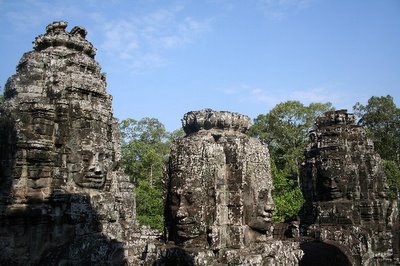
Roj, (our hired driver for the next three days), picked us up at 7.30am for the first of 3 day temple spotting. We had a very pleasant journey out to Angkor Thom, our first stop. Many people, (myself included), believe that Angkor Watt is esentially one big ol' temple, which it is. What I didn't know until I started to read up on it was that there is a whole complex of temples that tend to get lumped in together under the name 'Angkor Watt'. The complex covers an area so huge it'd be nigh on impossible to see them all in the three days we had so Roj was to take us to the 'best'.
Angkor Thom was our first stop and it really was spectacular. To get to Angkor Thom, (which is part of a 'mini-complex' called Banyon), you first pass through the south gate which is stunning in it's own right. The gate is approached by a stone bridge which is flanked on both sides by man-sized carved figures, (Smiling Gods on the left and frowning Demons on the right), both clutching a huge dragon. Sadly most of the heads are now replicas as most of these temples & Watts have been plundered.
Angkor Thom itself was unfortuantely festooned in Japanese tour groups so it was difficult to take in it's majesty for more than a few minutes at a time before a wee Japanese lass appeared in front of you doing the 'peace' sign in front of a beautifully carved relief while her mates snapped away and giggled like, well... like Japanese school girls really.
Outside Thom is the incredible Terrace of Elephants, a massive stone wall carved with the most intricate and beautiful depictions of elephants. The whole area really is a deeply moving place. Looking around we could see these vast ruinous temples slowly crumbling under the weight of the centuries, (and now under the weight of tourism), but this was surrounded by the most beautiful and peacefull scenery littered with other abandoned temple buildings that the surrounding jungle just couldn't completely swallow.
After fending off several hundred Cambodians who all wanted us to buy something, (all the stalls sell Tomb Raider on DVD along with a couple of other seemingly random Angelina Jolie films), we headed of to by far the most fascinating and wonderful of all the temples in Angkor, Ta Prohm. This is the temple that made Angkor internationally famous as it was the one used in the Tomb Raider film.
Bizzarely, just a couple of days previous on the good ol' BBC WORLD, Beth & I had watched with mounting horror a piece about the damage tourism was causing to Angkor. Apparently if you'd come here as little as five years ago you would've had the place pretty much to yourself, now it literally teems with life. Buses vomit out hordes of Japanese and Western tourists to clamber over these ancient stones and do in five years what nature and the encroaching jungle hasn't been able to do it several hundred. The frowning journalist showed one particular set off steps that were clearly ruined and mostly worn away and told us that just five years ago it was pretty much intact. The number of visitors to Angkor has risen by 40% in just one year. I very much doubt it can carry on in this way, it made us very sad and yet here we were doing exactly that. We like to think of ourselves as ecologically minded people and we did our best to respect the place and not to just crash about but there's no real 'structure' here so it's often impossible to get anywhere without climbing over something ancient.
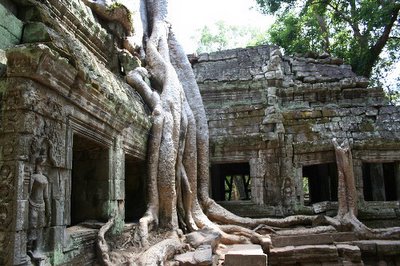
Anyhow, rant over for now. Ta Prohm. It's stunning. You'll almost certainly have seen this place in pictures or on the telly, (or in Tomb Raider), it's the one with the trees growing out of it. Not in it's grounds or around it, but out of the actual rocks. It really is amazing. The roots of these huge trees, (which themselves look older than than some modern countries and have taken on a similar colour to the walls), twist in and out of the stones and trees perch precariously on top of arches are temple walls. It's the perfect symiosis. The roots are causing the structures to crumble and fall apart and yet it's now only these very root systems that are keeping the walls together. They look like some giant alien parasite, both feeding and destroying. Despite the presence of tourists it was remarkably quiet here and we took our time to soak up the peace in preparation to our visit to Angkor Watt.

Everyone knows Angkor Watt and it would seem everyone goes there too. It sits in an open space approached by a massive stone bridge wider than many in London. Even the hordes of tourists in their hundreds are made to look tiny and insignificant. The Watt itself is huge and covered around the edge by equally huge reliefs depicting legends involving Gods & Demons. They have such crazy stories, I'm sure there was one about a dragon who gave birth to a king and his brother in a sea of milk. Nuts.
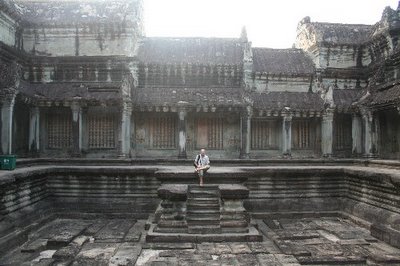
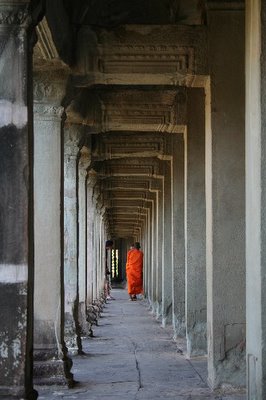
Unfortunately the Japanese tourists were out in force and clambering up and down the tiny steps that were only ever meant for the Gods and a select few. Outside the Watt Beth & I settled down next two one of the ornamental ponds to watch the sunset behind Angkor. It's difficult to take in the full splendour though when there's a mini-village of stalls selling fizzy-pop and crap souvenirs just behind you. We did our best to ignore the constant cries of "Buy something?", or "You wan wata? One dolla." One young girl came up and plonked her little sister in Beth's lap and asked, (with a big ol' grin on her face), if we wanted her for a dollar. They have a great sense of humour here and know how irritating the whole selling thing can be to us. The baby was cute as hell and Beth immediately fell in love with it.

The next day Roj took us on what is known as the Grand Tour. We took in Preah Khan, Preah Neak Pean, Ta Som, Eastern Mebon, Pre Rup, Banteay Kdei & Sras Srang. I wish I could think of something to write for each of these but after a while they all kind of blur into one. There's only so many ancient rocks and bas-reliefs you can look at before 'temple-fatigue' kicks in. Preah Khan and Preah Neak Pean stood out in our memories though, the first because we got there around mid-day so all the tour groups were having lunch. Consequently we were two amongst only about twelve people there so it was possible to wander freely and soak up the quiet. Preah Khan also has the crazy 'tree becoming rock' thing going on.
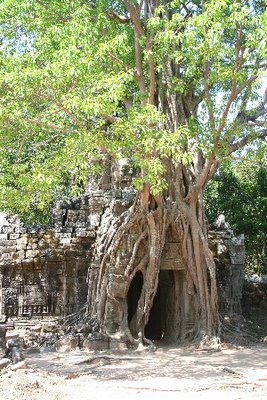
Preah Neak Pean is a great mini-temple that sits smack in the middle of a man-made reservoir surrounded by four smaller pools. Each of the smaller pools, (that sit at the four cardinal compass points), contains a fountain shaped like a human head, a lion, an elephant and a horse. The tiny central island is a small sandstone tower next to which is a statue of a giant horse 'rescuing' drowning seamen from the waters.
Neak Pean was built during the reign of King Jayavarman VII who ruled in the late 12th century. The King ordered the construction of a vast reservoir to provide water to its' workers. Stretching a half kilometer by 900 meters, the artificial lake stored millions of cubic meters of water to irrigate the rice fields during the dry season. Neak Pean sits at the center of the reservoir.
That evening had amazing wine & food at a highly cosmopolitan bar called 'Linga', (Thank God for the French influence here), which was amazing but the place turned unexpectedly into a slightly seedy gay pick-up bar at precisely 8.58pm.
Our final day of temple spotting took us to a handfull of places that don't really need mentioning. The standout however was Banteay Srei or The Citadel of Women, a bizzare and utterly brilliant 'mini-me' temple of pink sandstone. It's just like one of the normal sized temples but shrunk down to mini proportions. It's brilliant. The reliefs are superb here and in a very good state of repair. You feel like a giant wandering about here and having to crouch under doorways, (something I've become used too here in the land of wee-people).

Our three days over we headed back to Siem Reap to sup coffee and devour cake in The Blue Pupkin, one of the finest coffee shops I've ever been in anywhere.

No comments:
Post a Comment